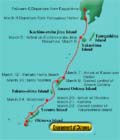The dispatch of troops to Korea was ended with the death of Toyotomi Hideyoshi in 1598. Tokugawa Ieyasu, who held most of the power in Japan, requested mediation from the Ryukyu Kingdom in order to restore the relationship with China, which had become strained due to the dispatch of troops to Korea. At the same time they hoped to get the Ryukyus under the control of the Shogunate. The Ryukyu Kingdom regarded relations with Ming as a priority and did not accede to the demands of the Shogunate. The Shimazu clan was in charge of negotiations to get the Ryukyus to obey the demands and also saw it as a chance to extricate itself from it's own financial difficulties. The Shimazu initiated planning to invade the Ryukyus. Initially the Shogunate refrained from military force, however unable to endure the obstinate refusal from Ryukyus; it issued the order allowing the Shimazu clan to carry out their invasion plan of the Ryukyus. The Shimazu clan entered the Ryukyu Islands through Amami Oshima Island and attacked with a force of some 3,000 in March 1609. The Ryukyu Kingdom having neither the weapons nor experience to do battle was defeated with minimal resistance in only ten days and was forced under Satsuma hegemony. King Sho Nei and his ministers were taken captive to Satsuma and detained for about two years. King Sho Nei underwent humiliation and was coerced into a written oath that stated; "Neither I, King Sho Nei, nor my descendents will ever betray the Shimazu clan." Though the Ryukyu Kingdom was still claimed to be an independent country, it was in fact subordinated under the Tokugawa.

